Spatial Prediction of Groundwater Withdrawal Potential Using Shallow, Hybrid, and Deep Learning Algorithms in the Toudgha Oasis, Southeast Morocco
Abstract
1. Introduction
2. Materials and Methods
2.1. The Study Area
2.2. Methodology and Data Sources
2.3. Database Generation
2.3.1. Water Withdrawal Points Inventorying
2.3.2. Mapping the GWP-Influencing Factor
2.3.3. GWP-Influencing Factors Optimized Selection Analysis
2.4. GWP Prediction Algorithms
2.5. Performance Analysis and Model’s Reinking
3. Results
3.1. GWP-Influencing Factors Selection
3.2. Groundwater Potentiality Maps
3.3. Models’ Performance
3.4. Models’ Prioritization
4. Discussion
4.1. Importance of GWP-Influencing Factors
4.2. Models’ Performance and Periodization
4.3. Effectiveness of the Used Methodology
5. Conclusions
Author Contributions
Funding
Institutional Review Board Statement
Informed Consent Statement
Data Availability Statement
Acknowledgments
Conflicts of Interest
References
- Hssaisoune, M.; Bouchaou, L.; Sifeddine, A.; Bouimetarhan, I.; Chehbouni, A. Moroccan Groundwater Resources and Evolution with Global Climate Changes. Geosciences 2020, 10, 81. [Google Scholar] [CrossRef]
- Boudhar, A.; Ouatiki, H.; Bouamri, H.; Lebrini, Y.; Karaoui, I.; Hssaisoune, M.; Arioua, A.; Benabdelouahab, T. Hydrological Response to Snow Cover Changes Using Remote Sensing over the Oum Er Rbia Upstream Basin, Morocco. In Advances in Science, Technology and Innovation; Springer: Cham, Switzerland, 2020. [Google Scholar]
- Ouali, L.; Hssaisoune, M.; Kabiri, L.; Slimani, M.M.; El Mouquaddam, K.; Namous, M.; Arioua, A.; Ben Moussa, A.; Benqlilou, H.; Bouchaou, L. Mapping of potential sites for rainwater harvesting structures using GIS and MCDM approaches: Case study of the Toudgha watershed, Morocco. Euro-Mediterr. J. Environ. Integr. 2022, 7, 49–64. [Google Scholar] [CrossRef]
- Khettouch, A.; Hssaisoune, M.; Maaziz, M.; Taleb, A.A.; Bouchaou, L. Characterization of groundwater in the arid Zenaga plain: Hydrochemical and environmental isotopes approaches. Groundw. Sustain. Dev. 2022, 19, 816. [Google Scholar] [CrossRef]
- Medici, G.; Langman, J.B. Pathways and Estimate of Aquifer Recharge in a Flood Basalt Terrain; A Review from the South Fork Palouse River Basin (Columbia River Plateau, USA). Sustainability 2022, 14, 11349. [Google Scholar] [CrossRef]
- Masoud, A.M.; Pham, Q.B.; Alezabawy, A.K.; Abu El-Magd, S.A. Efficiency of Geospatial Technology and Multi-Criteria Decision Analysis for Groundwater Potential Mapping in a Semi-Arid Region. Water 2022, 14, 882. [Google Scholar] [CrossRef]
- United Nations. The United Nations World Water Development Report 2022: Groundwater: Making the Invisible Visible; United Nations: Paris, France, 2022. [Google Scholar]
- Manna, F.; Kennel, J.; Parker, B.L. Understanding mechanisms of recharge through fractured sandstone using high-frequency water-level-response data. Hydrogeol. J. 2022, 30, 1599–1618. [Google Scholar] [CrossRef]
- Talukdar, S.; Mallick, J.; Sarkar, S.K.; Roy, S.K.; Islam, A.R.M.T.; Praveen, B.; Naikoo, M.W.; Rahman, A.; Sobnam, M. Novel hybrid models to enhance the efficiency of groundwater potentiality model. Appl. Water Sci. 2022, 12, 1–22. [Google Scholar] [CrossRef]
- Díaz-Alcaide, S.; Martínez-Santos, P. Review: Advances in groundwater potential mapping. Hydrogeol. J. 2019, 27, 2307–2324. [Google Scholar] [CrossRef]
- Arabameri, A.; Pal, S.C.; Rezaie, F.; Nalivan, O.A.; Chowdhuri, I.; Saha, A.; Lee, S.; Moayedi, H. Modeling groundwater potential using novel GIS-based machine-learning ensemble techniques. J. Hydrol. Reg. Stud. 2021, 36, 100848. [Google Scholar] [CrossRef]
- Lee, S.; Hyun, Y.; Lee, M.-J. Groundwater Potential Mapping Using Data Mining Models of Big Data Analysis in Goyang-si, South Korea. Sustainability 2019, 11, 1678. [Google Scholar] [CrossRef]
- Park, S.; Kim, J. The Predictive Capability of a Novel Ensemble Tree-Based Algorithm for Assessing Groundwater Potential. Sustainability 2021, 13, 2459. [Google Scholar] [CrossRef]
- Liu, R.; Li, G.; Wei, L.; Xu, Y.; Gou, X.; Luo, S.; Yang, X. Spatial prediction of groundwater potentiality using machine learning methods with Grey Wolf and Sparrow Search Algorithms. J. Hydrol. 2022, 610, 127977. [Google Scholar] [CrossRef]
- Moodley, T.; Seyam, M.; Abunama, T.; Bux, F. Delineation of groundwater potential zones in KwaZulu-Natal, South Africa using remote sensing, GIS and AHP. J. Afr. Earth Sci. 2022, 193, 104571. [Google Scholar] [CrossRef]
- Pandey, P.C.; Sharma, L.K. Introduction to Natural Resource Monitoring Using Remote Sensing Technology. In Advances in Remote Sensing for Natural Resource Monitoring; Springer: Berlin, Germany, 2021. [Google Scholar]
- Shit, P.K.; Bhunia, G.S.; Adhikary, P.P.; Dash, C.J. Introduction to Groundwater and Society: Applications of Geospatial Technology. In Groundwater and Society; Springer: Cham, Switzerland, 2021. [Google Scholar]
- Das, S. Geographic information system and AHP-based flood hazard zonation of Vaitarna basin, Maharashtra, India. Arab. J. Geosci. 2018, 11, 576. [Google Scholar] [CrossRef]
- Maskooni, E.K.; Naghibi, S.; Hashemi, H.; Berndtsson, R. Application of Advanced Machine Learning Algorithms to Assess Groundwater Potential Using Remote Sensing-Derived Data. Remote Sens. 2020, 12, 2742. [Google Scholar] [CrossRef]
- Namous, M.; Hssaisoune, M.; Pradhan, B.; Lee, C.-W.; Alamri, A.; Elaloui, A.; Edahbi, M.; Krimissa, S.; Eloudi, H.; Ouayah, M.; et al. Spatial Prediction of Groundwater Potentiality in Large Semi-Arid and Karstic Mountainous Region Using Machine Learning Models. Water 2021, 13, 2273. [Google Scholar] [CrossRef]
- Naghibi, S.A.; Hashemi, H.; Berndtsson, R.; Lee, S. Application of extreme gradient boosting and parallel random forest algorithms for assessing groundwater spring potential using DEM-derived factors. J. Hydrol. 2020, 589, 125197. [Google Scholar] [CrossRef]
- Pham, Q.B.; Kumar, M.; Di Nunno, F.; Elbeltagi, A.; Granata, F.; Islam, A.R.M.T.; Talukdar, S.; Nguyen, X.C.; Ahmed, A.N.; Anh, D.T. Groundwater level prediction using machine learning algorithms in a drought-prone area. Neural Comput. Appl. 2022, 34, 10751–10773. [Google Scholar] [CrossRef]
- Das, R.; Saha, S. Spatial mapping of groundwater potentiality applying ensemble of computational intelligence and machine learning approaches. Groundw. Sustain. Dev. 2022, 18, 100778. [Google Scholar] [CrossRef]
- Gómez-Escalonilla, V.; Martínez-Santos, P.; Martín-Loeches, M. Preprocessing approaches in machine-learning-based groundwater potential mapping: An application to the Koulikoro and Bamako regions, Mali. Hydrol. Earth Syst. Sci. 2022, 26, 221–243. [Google Scholar] [CrossRef]
- Hakim, W.L.; Nur, A.S.; Rezaie, F.; Panahi, M.; Lee, C.-W.; Lee, S. Convolutional neural network and long short-term memory algorithms for groundwater potential mapping in Anseong, South Korea. J. Hydrol. Reg. Stud. 2022, 39, 100990. [Google Scholar] [CrossRef]
- Mosavi, A.; Hosseini, F.S.; Choubin, B.; Goodarzi, M.; Dineva, A.A.; Sardooi, E.R. Ensemble Boosting and Bagging Based Machine Learning Models for Groundwater Potential Prediction. Water Resour. Manag. 2020, 35, 23–37. [Google Scholar] [CrossRef]
- Chen, Y.; Chen, W.; Pal, S.C.; Saha, A.; Chowdhuri, I.; Adeli, B.; Janizadeh, S.; Dineva, A.A.; Wang, X.; Mosavi, A. Evaluation efficiency of hybrid deep learning algorithms with neural network decision tree and boosting methods for predicting groundwater potential. Geocarto Int. 2021, 37, 5564–5584. [Google Scholar] [CrossRef]
- Liu, H.; Lang, B. Machine Learning and Deep Learning Methods for Intrusion Detection Systems: A Survey. Appl. Sci. 2019, 9, 4396. [Google Scholar] [CrossRef]
- Sahour, H.; Gholami, V.; Vazifedan, M. A comparative analysis of statistical and machine learning techniques for mapping the spatial distribution of groundwater salinity in a coastal aquifer. J. Hydrol. 2020, 591, 125321. [Google Scholar] [CrossRef]
- Dominguez, P.; Benessaiah, N. Multi-agentive transformations of rural livelihoods in mountain ICCAs: The case of the decline of community-based management of natural resources in the Mesioui agdals (Morocco). Quat. Int. 2017, 437, 165–175. [Google Scholar] [CrossRef]
- Labbaf Khaneiki, M. Territorial Water Cooperation in the Central Plateau of Iran; Springer: Cham, Switzerland, 2019; ISBN 9783030014940. [Google Scholar]
- Hejja, Y.; Baidder, L.; Ibouh, H.; Bba, A.N.; Soulaimani, A.; Gaouzi, A.; Maacha, L. Fractures distribution and basement-cover interaction in a polytectonic domain: A case study from the Saghro Massif (Eastern Anti-Atlas, Morocco). J. Afr. Earth Sci. 2020, 162, 103694. [Google Scholar] [CrossRef]
- Moratti, G.; Benvenuti, M.; Santo, A.P.; Laurenzi, M.A.; Braschi, E.; Tommasini, S. New 40Ar–39Ar dating of Lower Cretaceous basalts at the southern front of the Central High Atlas, Morocco: Insights on late Mesozoic tectonics, sedimentation and magmatism. Int. J. Earth Sci. 2018, 107, 2491–2515. [Google Scholar] [CrossRef]
- Essafraoui, B.; Ferry, S.; Groshény, D.; Içame, N.; El Aouli, H.; Masrour, M.; Bulot, L.G.; Géraud, Y.; Aoutem, M. Sequence stratigraphic architecture of marine to fluvial deposits across a passive margin (Cenomanian, Atlantic margin, Morocco, Agadir transect). Carnets Geol. 2015, 15, 137–172. [Google Scholar] [CrossRef]
- Meister, C.; Piuz, A.; Cavin, L.; Boudad, L.; Bacchia, F.; Ettachfini, E.M.; Benyoucef, M. Late Cretaceous (Cenomanian-Turonian) ammonites from southern Morocco and south western Algeria. Arab. J. Geosci. 2016, 10, 1. [Google Scholar] [CrossRef]
- Ellero, A.; Ottria, G.; Malusà, M.G.; Ouanaimi, H. Structural Geological Analysis of the High Atlas (Morocco): Evidences of a Transpressional Fold-Thrust Belt. In Tectonics-Recent Advances; Intech Open: London, UK, 2012. [Google Scholar] [CrossRef]
- Michard, A.; Soulaimani, A.; Ouanaimi, H.; Raddi, Y.; Brahim, L.A.; Rjimati, E.-C.; Baidder, L.; Saddiqi, O. Saghro Group in the Ougnat Massif (Morocco), an evidence for a continuous Cadomian basin along the northern West African Craton. C. R. Geosci. 2017, 349, 81–90. [Google Scholar] [CrossRef]
- Margat, J. Le Haut Atlas Calcaire–(Hydrogéologie Du Maroc-Chap. VI-2). Notes et Mémoires Du Service. Géologique Du Maroc 1952, 97, 254–262. [Google Scholar]
- Margat, J.; Destombes, J.; Hollard, H. Mémoire Explicatif de La Carte Hydrogéologique Au 1: 50000 de La Plaine Du Tafilalt; Éditions du Service Géologique du Maroc: Rabat, Marocco, 1962. [Google Scholar]
- Ruhard, J.P. Le Bassin Quaternaire Du Tafilalt. In Ressources En Eau Du Maroc; Éditions du Service Géologique du Maroc: Rabat, Marocco, 1977; pp. 352–415. [Google Scholar]
- Bahaj, T.; Kacimi, I.; Hilali, M.; Kassou, N.; Mahboub, A. Preliminary Study of the Groundwater Geochemistry in the Sub-desert Area in Morocco: Case of the Ziz-Ghris Basins. Procedia Earth Planet. Sci. 2013, 7, 44–48. [Google Scholar] [CrossRef]
- Baki, S.; Hilali, M.; Kacimi, I.; Mahboub, A. Hydrogeological Characterization and Mapping of Water Resources in the Rheris Watershed (Southeast Morocco). Bull. l’Institut Sci. Sect. Sci. la Terre 2016, 38, 29–43. [Google Scholar]
- NASA/JAXA The Global Precipitation Mission. Available online: https://giovanni.gsfc.nasa.gov (accessed on 1 July 2022).
- Wang, H.; Gao, J.E.; Zhang, M.-J.; Li, X.-H.; Zhang, S.-L.; Jia, L.-Z. Effects of rainfall intensity on groundwater recharge based on simulated rainfall experiments and a groundwater flow model. Catena 2015, 127, 80–91. [Google Scholar] [CrossRef]
- Amano, H.; Iwasaki, Y. Land Cover Classification by Integrating NDVI Time Series and GIS Data to Evaluate Water Circulation in Aso Caldera, Japan. Int. J. Environ. Res. Public Health 2020, 17, 6605. [Google Scholar] [CrossRef]
- Grinevskii, S.O. The effect of topography on the formation of groundwater recharge. Mosc. Univ. Geol. Bull. 2014, 69, 47–52. [Google Scholar] [CrossRef]
- USDA Urban Hydrology for Small Watersheds; United States Department of Agriculture: Washington, DC, USA, 1975.
- Kunkle, S.H.; Thames, J.L. Techniques Hydrologiques de Conservation Des Terres et Des Eaux En Montagne; FAO: Rome, Italy, 1976; ISBN 9252001158/9789252001157. [Google Scholar]
- O’Brien, R.M. A Caution Regarding Rules of Thumb for Variance Inflation Factors. Qual. Quant. 2007, 41, 673–690. [Google Scholar] [CrossRef]
- Zhou, H.; Wang, X.; Zhu, R. Feature selection based on mutual information with correlation coefficient. Appl. Intell. 2021, 52, 5457–5474. [Google Scholar] [CrossRef]
- Mao, Z.; Shi, S.; Li, H.; Zhong, J.; Sun, J. Landslide susceptibility assessment using triangular fuzzy number-analytic hierarchy processing (TFN-AHP), contributing weight (CW) and random forest weighted frequency ratio (RF weighted FR) at the Pengyang county, Northwest China. Environ. Earth Sci. 2022, 81, 1–33. [Google Scholar] [CrossRef]
- Jenks, G.F. The Data Model Concept in Statistical Mapping. Int. Yearb. Cartogr. 1967, 7, 186–190. [Google Scholar]
- Sarker, I.H. Machine Learning: Algorithms, Real-World Applications and Research Directions. SN Comput. Sci. 2021, 2, 1–21. [Google Scholar] [CrossRef] [PubMed]
- Rosenblatt, F. The perceptron: A probabilistic model for information storage and organization in the brain. Psychol. Rev. 1958, 65, 386–408. [Google Scholar] [CrossRef] [PubMed]
- Rumelhart, D.E.; Hinton, G.E.; Williams, R.J. Learning representations by back-propagating errors. Nature 1986, 323, 533–536. [Google Scholar] [CrossRef]
- Farooq, M.U.; Zafar, A.M.; Raheem, W.; Jalees, M.I.; Hassan, A.A. Assessment of Algorithm Performance on Predicting Total Dissolved Solids Using Artificial Neural Network and Multiple Linear Regression for the Groundwater Data. Water 2022, 14, 2002. [Google Scholar] [CrossRef]
- Kanj, F.; Sawaya, R.; Halwani, J.; Nehmeh, N. Mercury prediction in groundwater of Naameh Landfill using an Artificial Neural Network (ANN) model. Green Technol. Resil. Sustain. 2022, 2, 1–14. [Google Scholar] [CrossRef]
- Fix, E.; Hodges, J. Discriminatory Analysis Nonparametric Discrimination: Small Sample Performance. Technical Report; University of California: Berkeley, CA, USA, 1952. [Google Scholar]
- Cover, T.; Hart, P. Nearest neighbor pattern classification. IEEE Trans. Inf. Theory 1967, 13, 21–27. [Google Scholar] [CrossRef]
- Kombo, O.; Kumaran, S.; Sheikh, Y.; Bovim, A.; Jayavel, K. Long-Term Groundwater Level Prediction Model Based on Hybrid KNN-RF Technique. Hydrology 2020, 7, 59. [Google Scholar] [CrossRef]
- Aburub, F.; Hadi, W. Predicting Groundwater Areas Using Data Mining Techniques: Groundwater in Jordan as Case Study. Int. J. Comput. Electr. Autom. Control Inf. Eng. 2016, 10, 1621–1624. [Google Scholar]
- Breiman, L.; Friedman, J.H.; Olshen, R.A.; Stone, C.J. Classification and Regression Trees; Routledge: London, UK, 2017. [Google Scholar]
- Zhao, Y.; Li, Y.; Zhang, L.; Wang, Q. Groundwater level prediction of landslide based on classification and regression tree. Geodesy Geodyn. 2016, 7, 348–355. [Google Scholar] [CrossRef]
- Choubin, B.; Rahmati, O.; Soleimani, F.; Alilou, H.; Moradi, E.; Alamdari, N. Regional Groundwater Potential Analysis Using Classification and Regression Trees. In Spatial Modeling in GIS and R for Earth and Environmental Sciences; Elsevier: Amsterdam, The Netherlands, 2019. [Google Scholar]
- Bottou, L.; Vapnik, V. Pattern Recognition Using Generalized Portrait Method. Autom. Remont Contr. 1963, 24, 774–780. [Google Scholar]
- Cortes, C.; Vapnik, V. Support-Vector Networks. Mach. Learn. 1995, 20, 273–297. [Google Scholar] [CrossRef]
- Liu, D.; Mishra, A.K.; Yu, Z.; Lü, H.; Li, Y. Support vector machine and data assimilation framework for Groundwater Level Forecasting using GRACE satellite data. J. Hydrol. 2021, 603, 126929. [Google Scholar] [CrossRef]
- Ijlil, S.; Essahlaoui, A.; Mohajane, M.; Essahlaoui, N.; Mili, E.M.; Van Rompaey, A. Machine Learning Algorithms for Modeling and Mapping of Groundwater Pollution Risk: A Study to Reach Water Security and Sustainable Development (Sdg) Goals in a Mediterranean Aquifer System. Remote Sens. 2022, 14, 2379. [Google Scholar] [CrossRef]
- Littlestone, N.; Warmuth, M.K. The Weighted Majority Algorithm. Inf. Comput. 1994, 108, 212–261. [Google Scholar] [CrossRef]
- Saqlain, M.; Jargalsaikhan, B.; Lee, J.Y. A Voting Ensemble Classifier for Wafer Map Defect Patterns Identification in Semiconductor Manufacturing. IEEE Trans. Semicond. Manuf. 2019, 32, 171–182. [Google Scholar] [CrossRef]
- Breiman, L. Random forests. Mach. Learn. 2001, 45, 5–32. [Google Scholar] [CrossRef]
- Freund, Y.; Schapire, R.E. Experiments with a New Boosting Algorithm. In Proceedings of the 13th International Conference Machine Learning, Bari, Italy, 3–6 July 1996. [Google Scholar]
- Ridgeway, G. The State of Boosting. Comput. Sci. Stat. 1999, 31. [Google Scholar]
- Chen, T.; Guestrin, C. XGBoost: A Scalable Tree Boosting System. In Proceedings of the ACM SIGKDD International Conference on Knowledge Discovery and Data Mining, San Francisco, CA, USA, 13–17 August 2016. [Google Scholar]
- Kingma, D.P.; Ba, J.L. Adam: A Method for Stochastic Optimization. In Proceedings of the 3rd International Conference on Learning Representations, ICLR 2015-Conference Track Proceedings, San Diego, CA, USA, 7–9 May 2015. [Google Scholar]
- Pradhan, A.M.S.; Kim, Y.-T.; Shrestha, S.; Huynh, T.-C.; Nguyen, B.-P. Application of deep neural network to capture groundwater potential zone in mountainous terrain, Nepal Himalaya. Environ. Sci. Pollut. Res. 2020, 28, 18501–18517. [Google Scholar] [CrossRef]
- Nwaila, G.T.; Zhang, S.E.; Bourdeau, J.E.; Negwangwatini, E.; Rose, D.H.; Burnett, M.; Ghorbani, Y. Data-Driven Predictive Modeling of Lithofacies and Fe In-Situ Grade in the Assen Fe Ore Deposit of the Transvaal Supergroup (South Africa) and Implications on the Genesis of Banded Iron Formations. Nat. Resour. Res. 2022, 31, 2369–2395. [Google Scholar] [CrossRef]
- Sameen, M.I.; Pradhan, B.; Lee, S. Self-Learning Random Forests Model for Mapping Groundwater Yield in Data-Scarce Areas. Nat. Resour. Res. 2018, 28, 757–775. [Google Scholar] [CrossRef]
- Phung, V.H.; Rhee, E.J. A Deep Learning Approach for Classification of Cloud Image Patches on Small Datasets. J. Inf. Commun. Converg. Eng. 2018, 16, 173–178. [Google Scholar] [CrossRef]
- Ahmadi, A.; Olyaei, M.; Heydari, Z.; Emami, M.; Zeynolabedin, A.; Ghomlaghi, A.; Daccache, A.; Fogg, G.E.; Sadegh, M. Groundwater Level Modeling with Machine Learning: A Systematic Review and Meta-Analysis. Water 2022, 14, 949. [Google Scholar] [CrossRef]
- Afrifa, S.; Zhang, T.; Appiahene, P.; Varadarajan, V. Mathematical and Machine Learning Models for Groundwater Level Changes: A Systematic Review and Bibliographic Analysis. Future Internet 2022, 14, 259. [Google Scholar] [CrossRef]

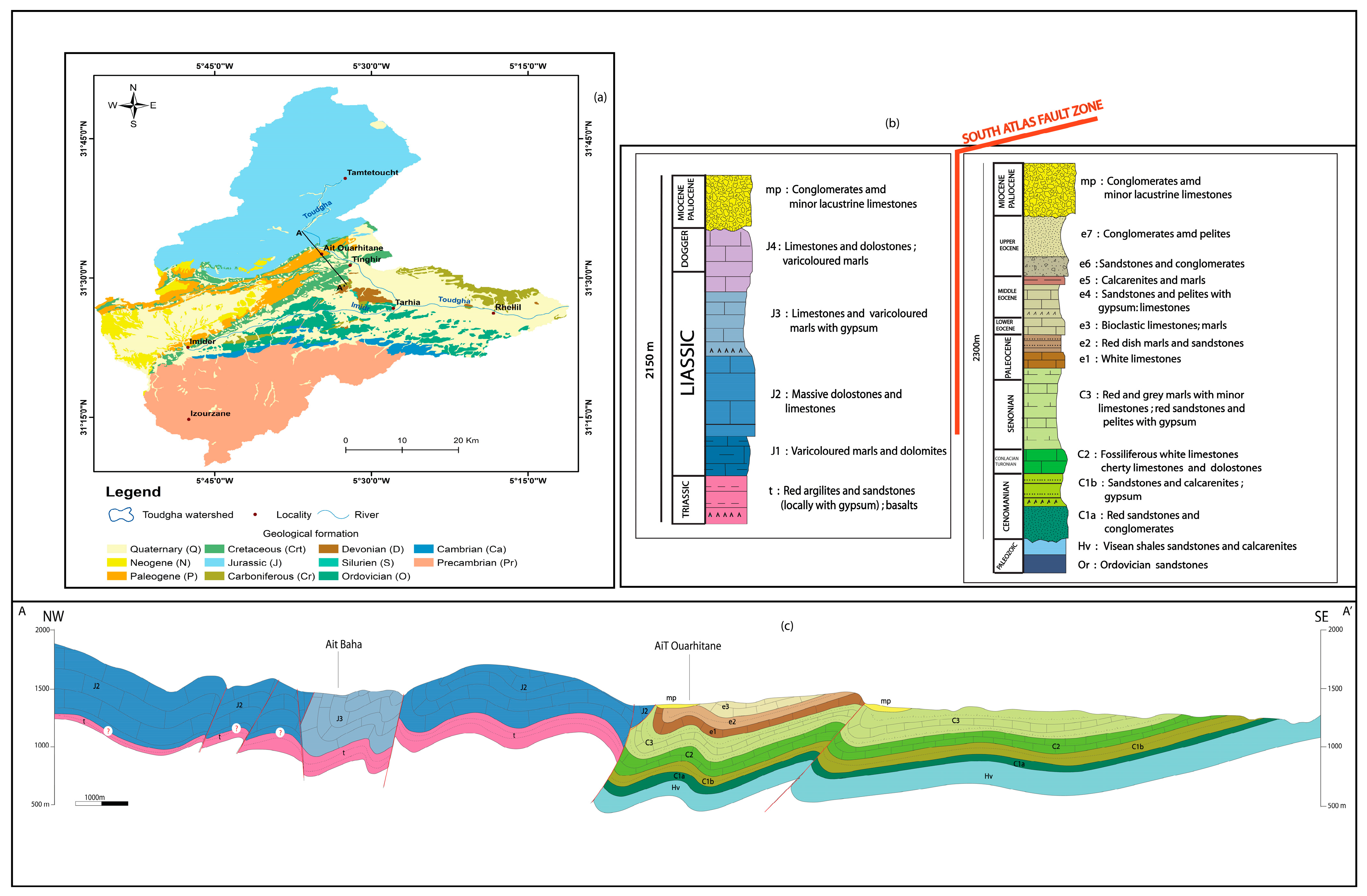
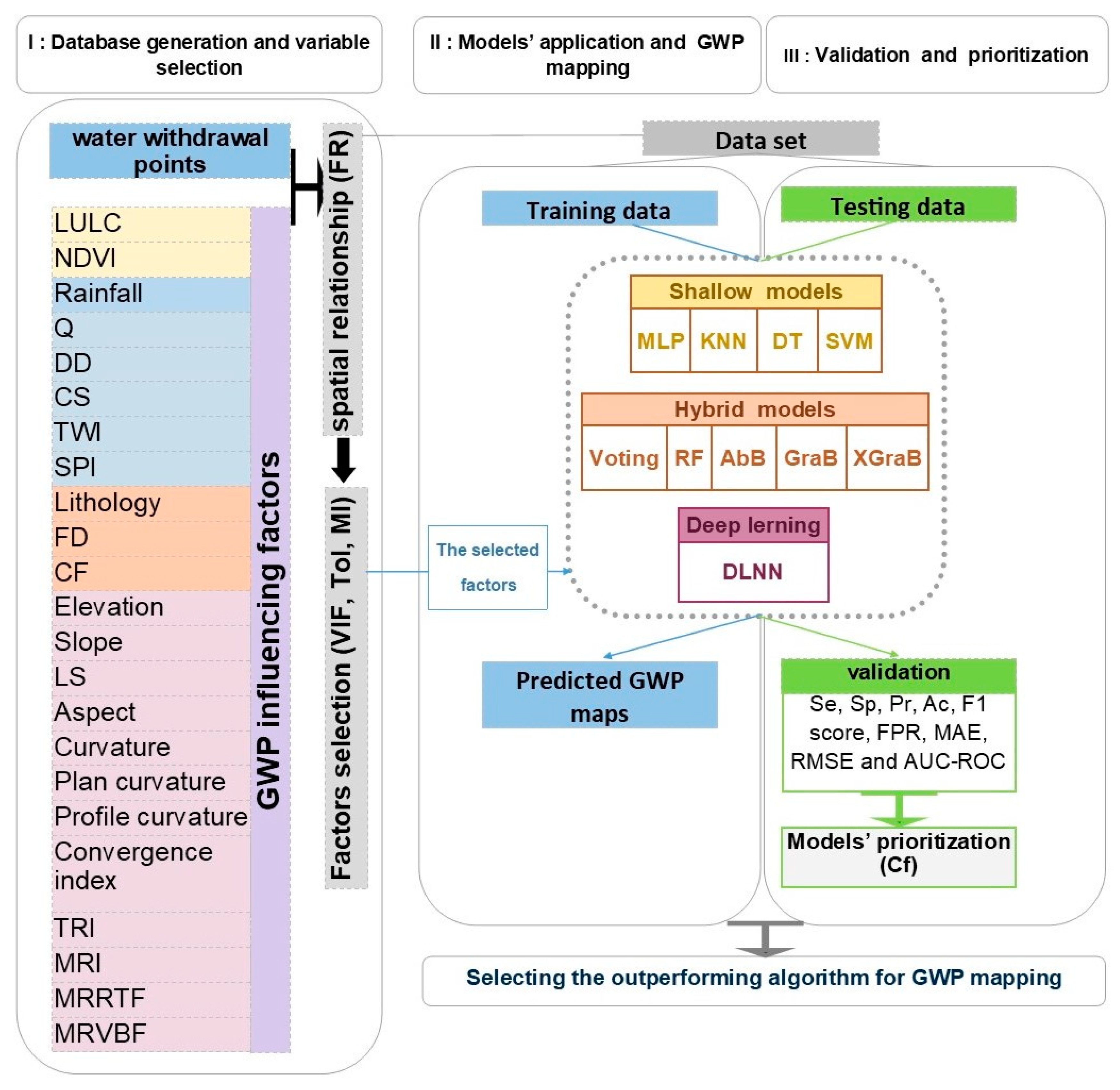

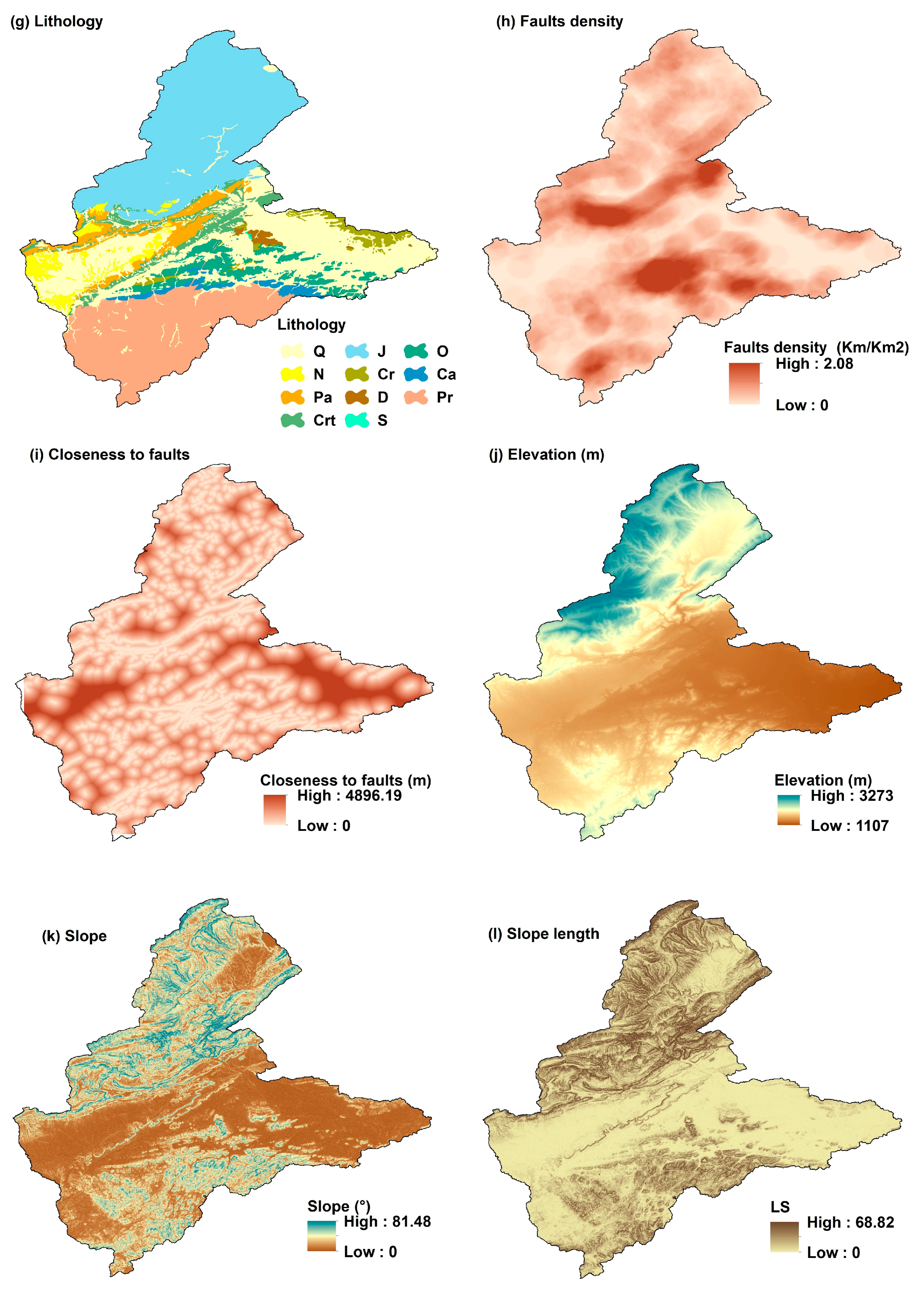
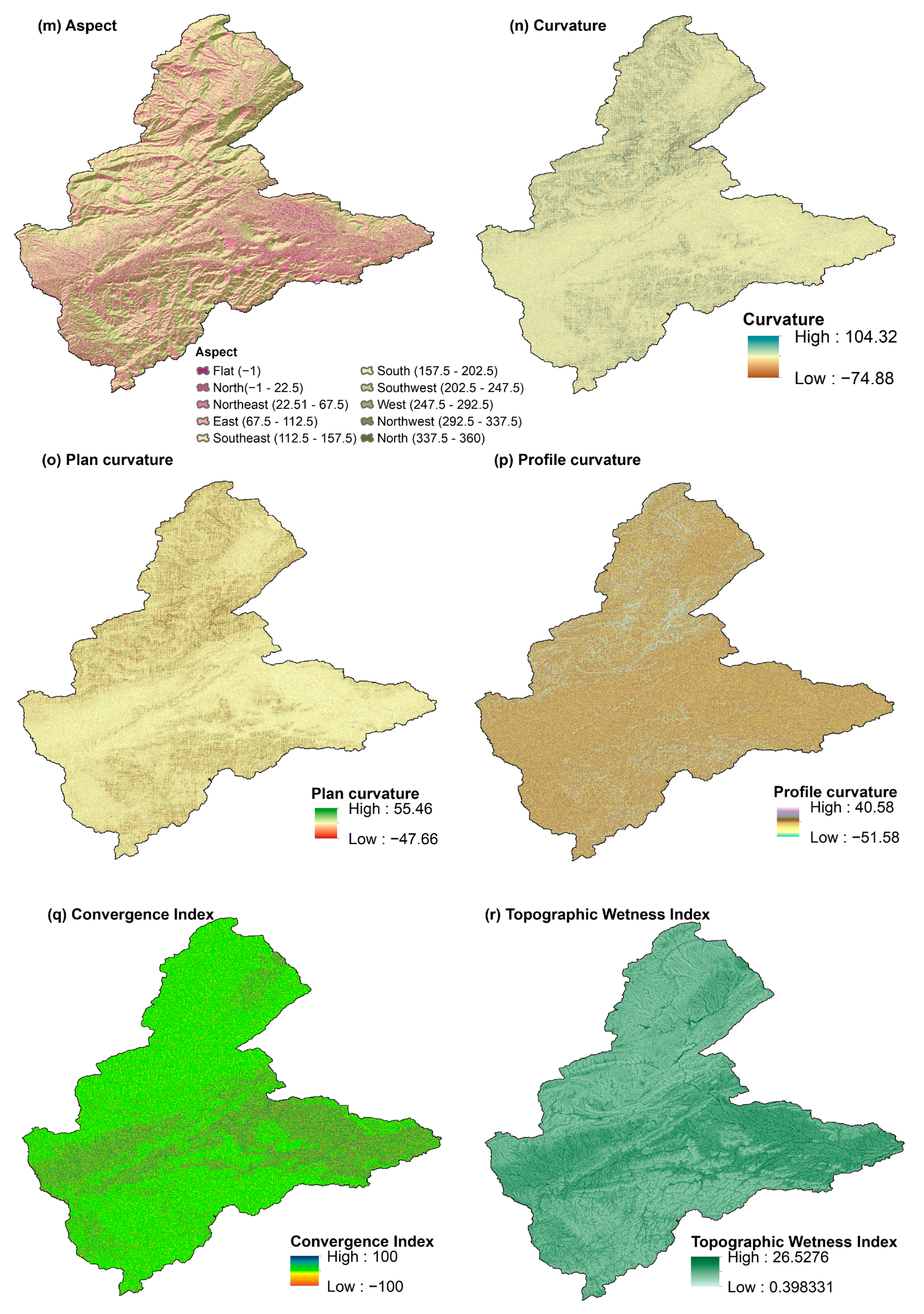
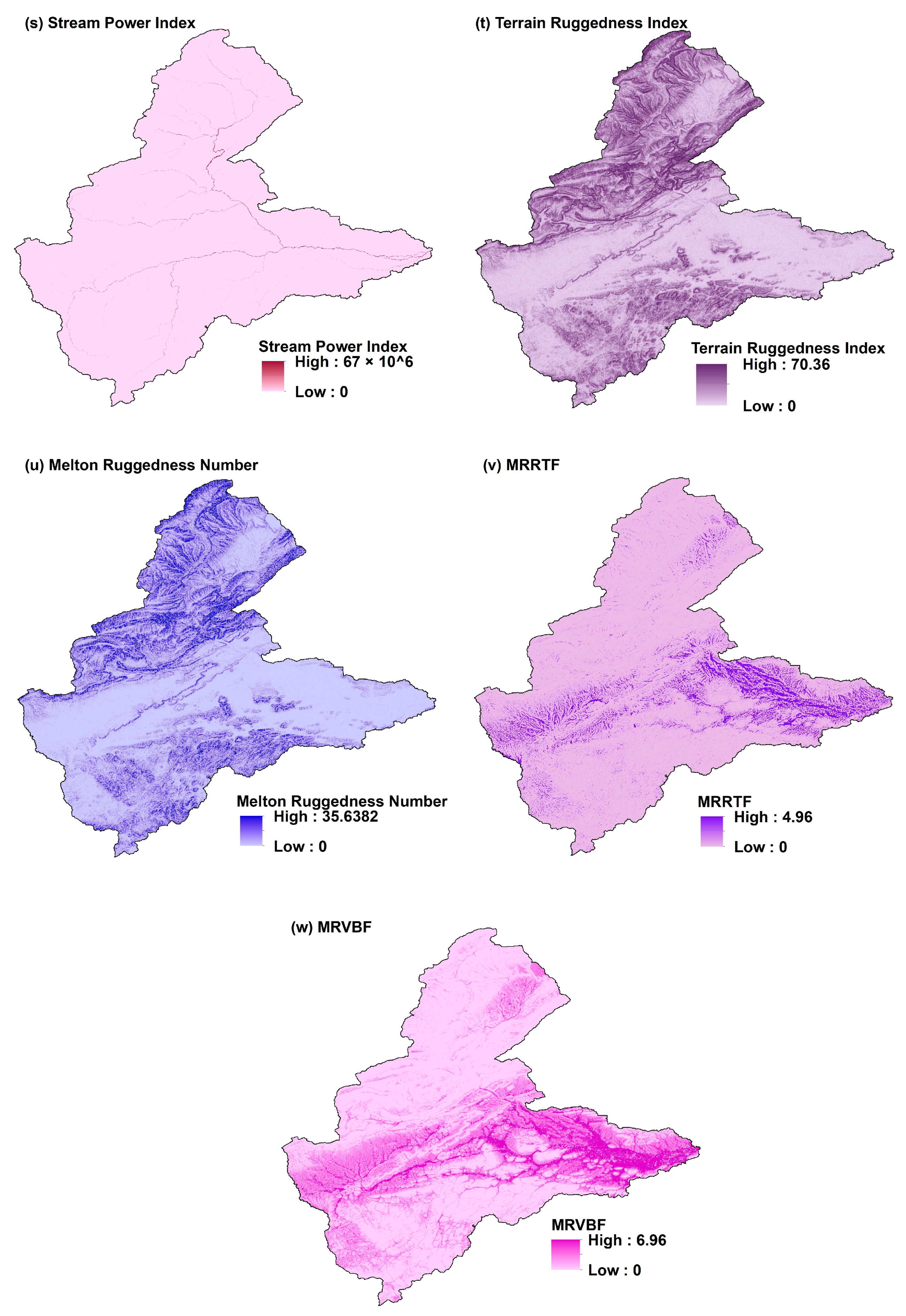
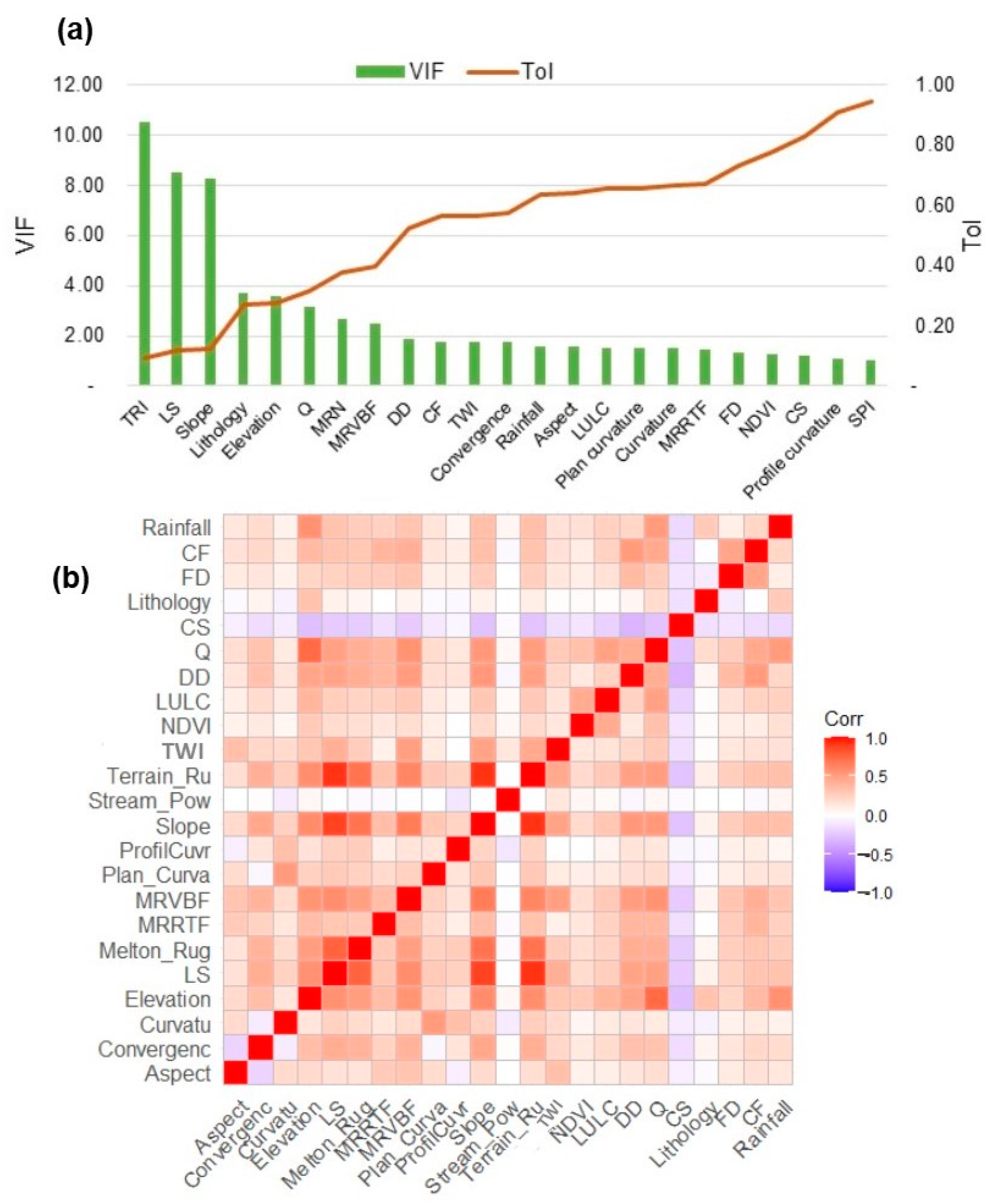
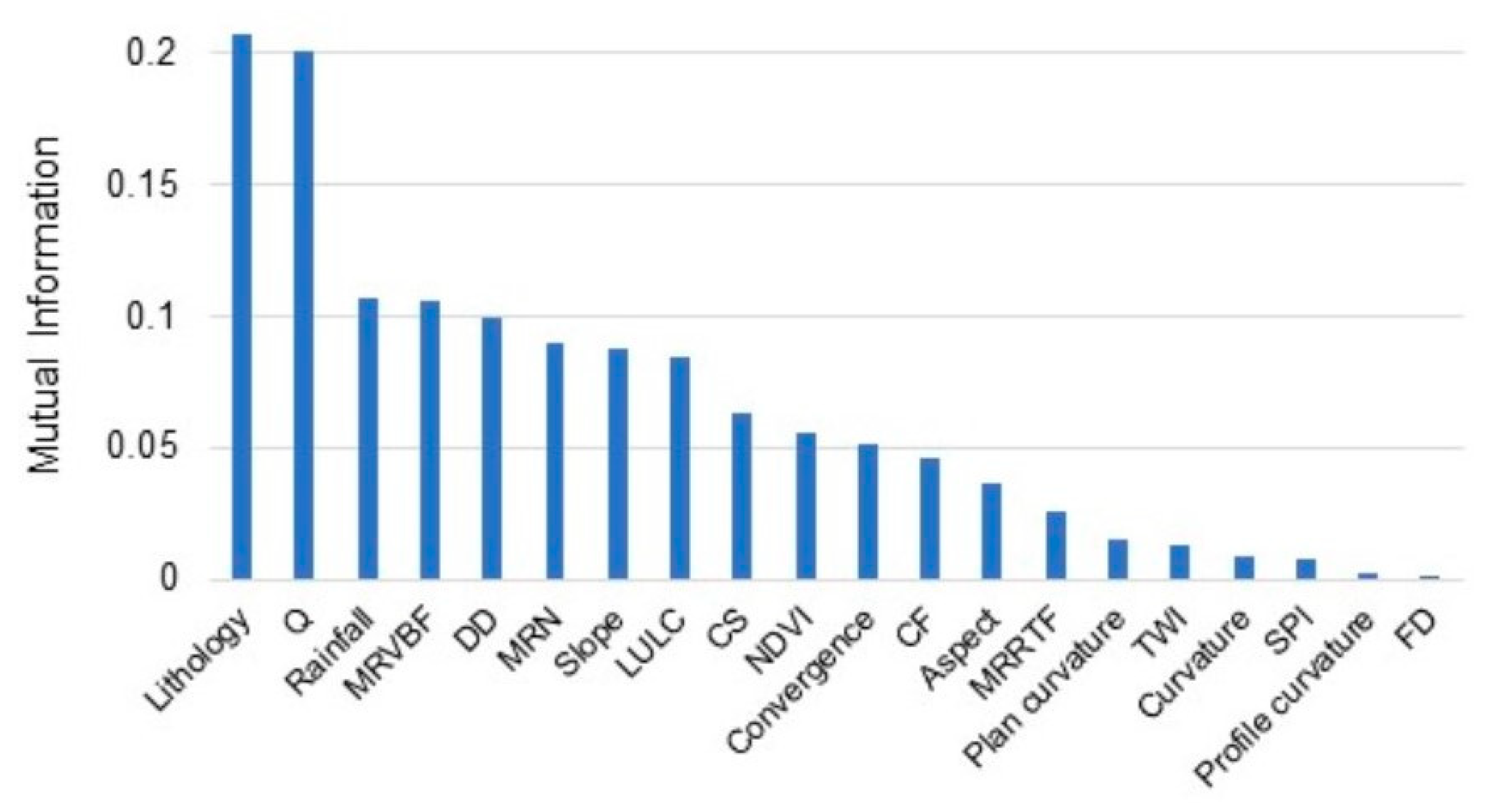
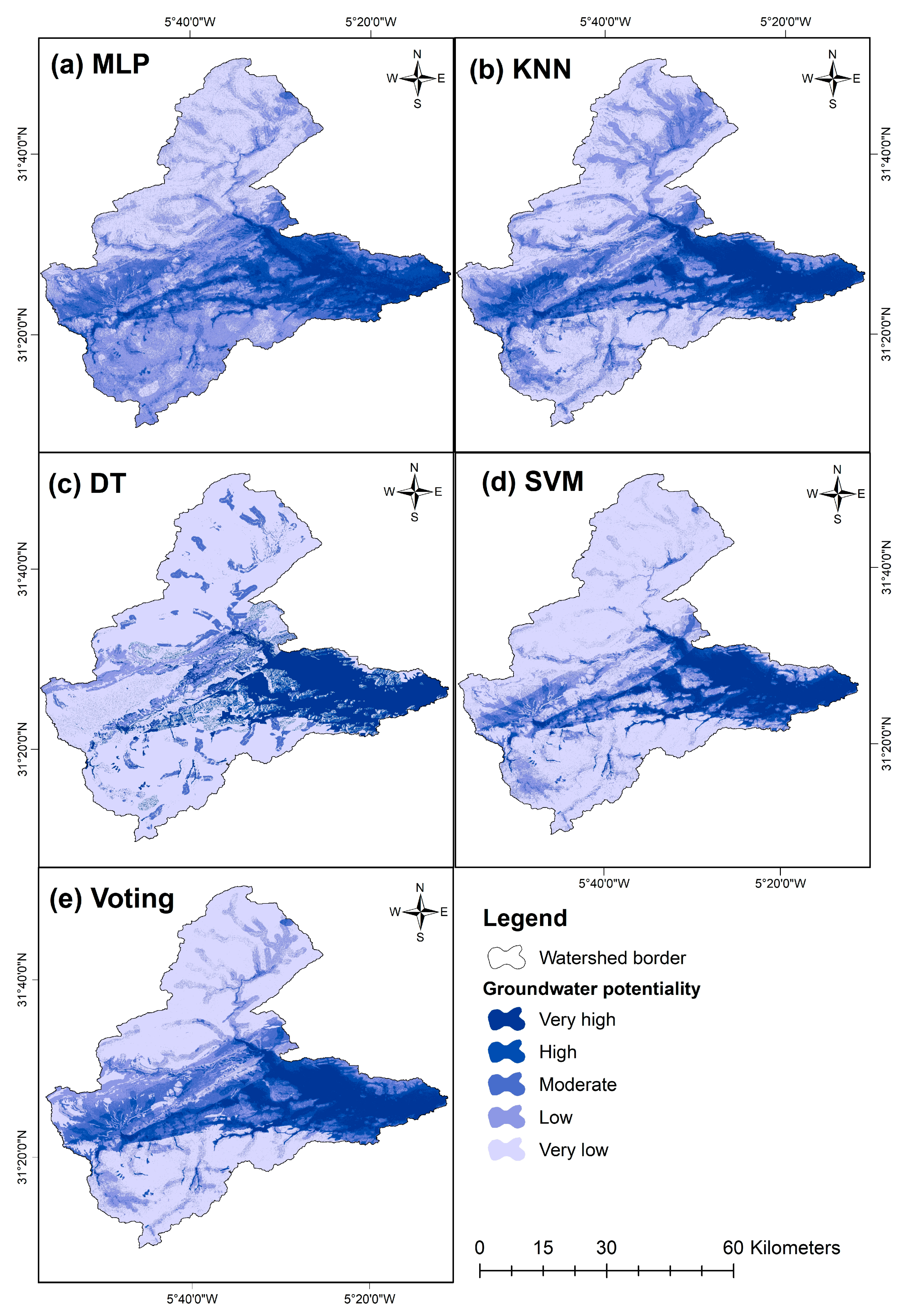
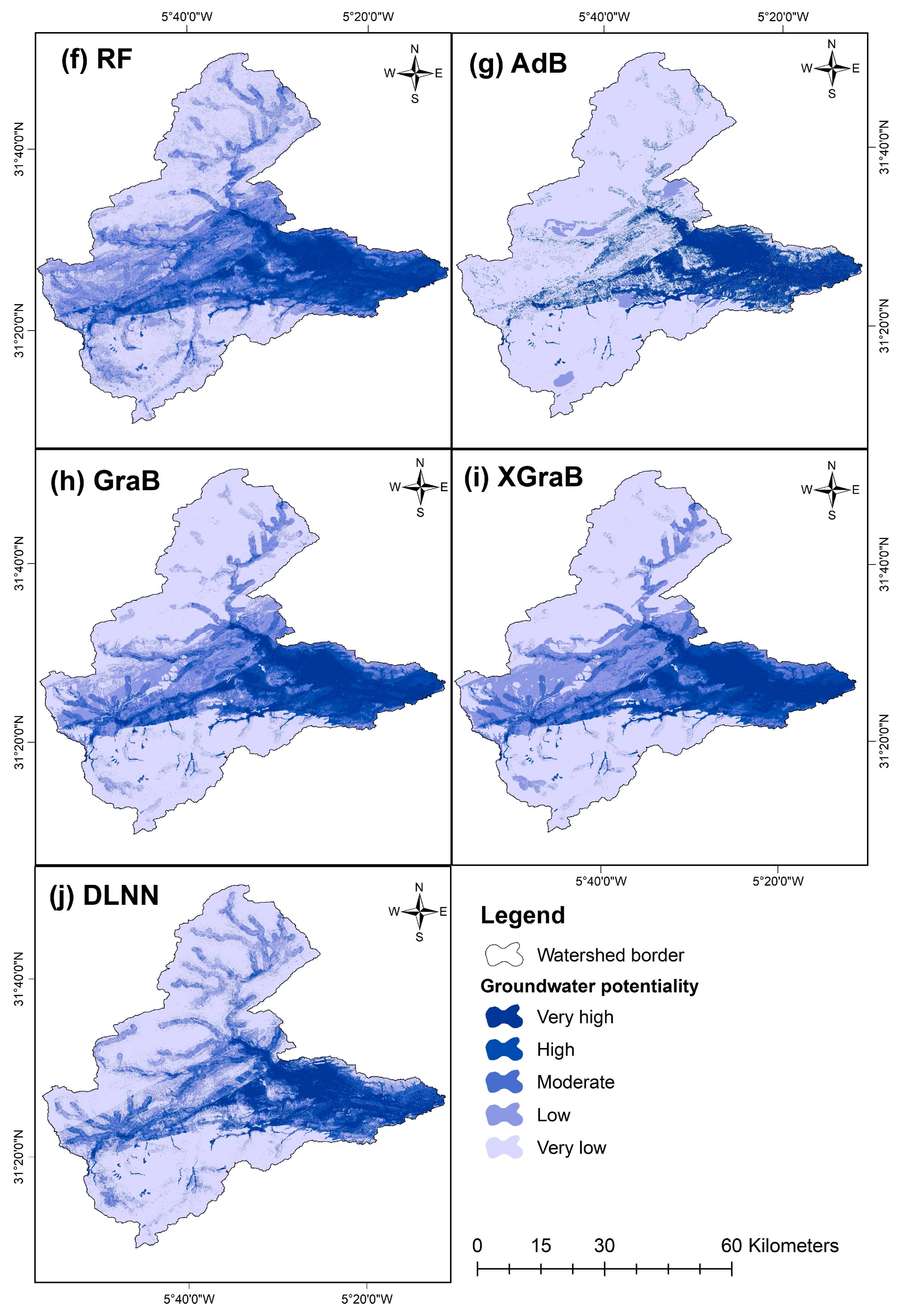


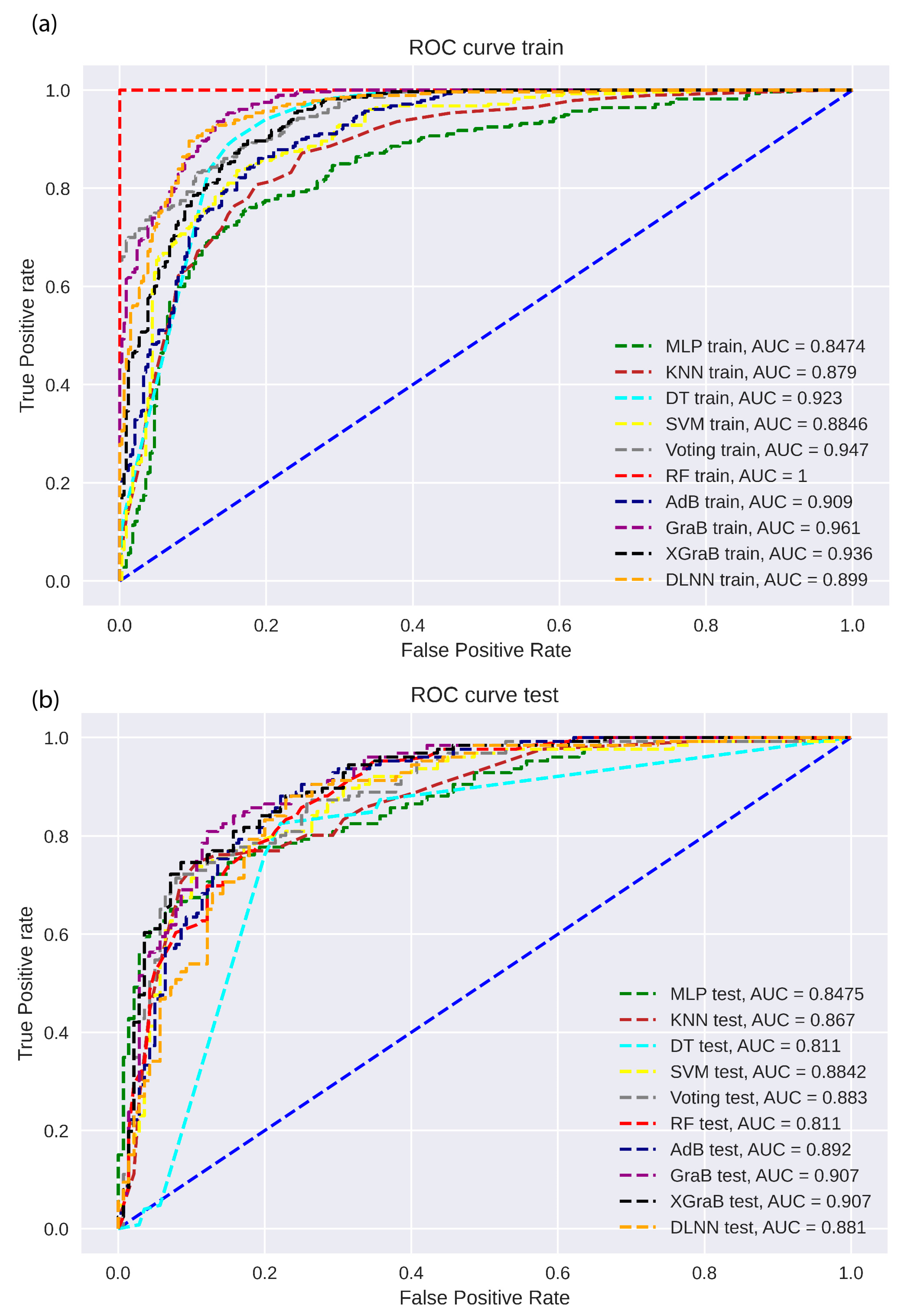
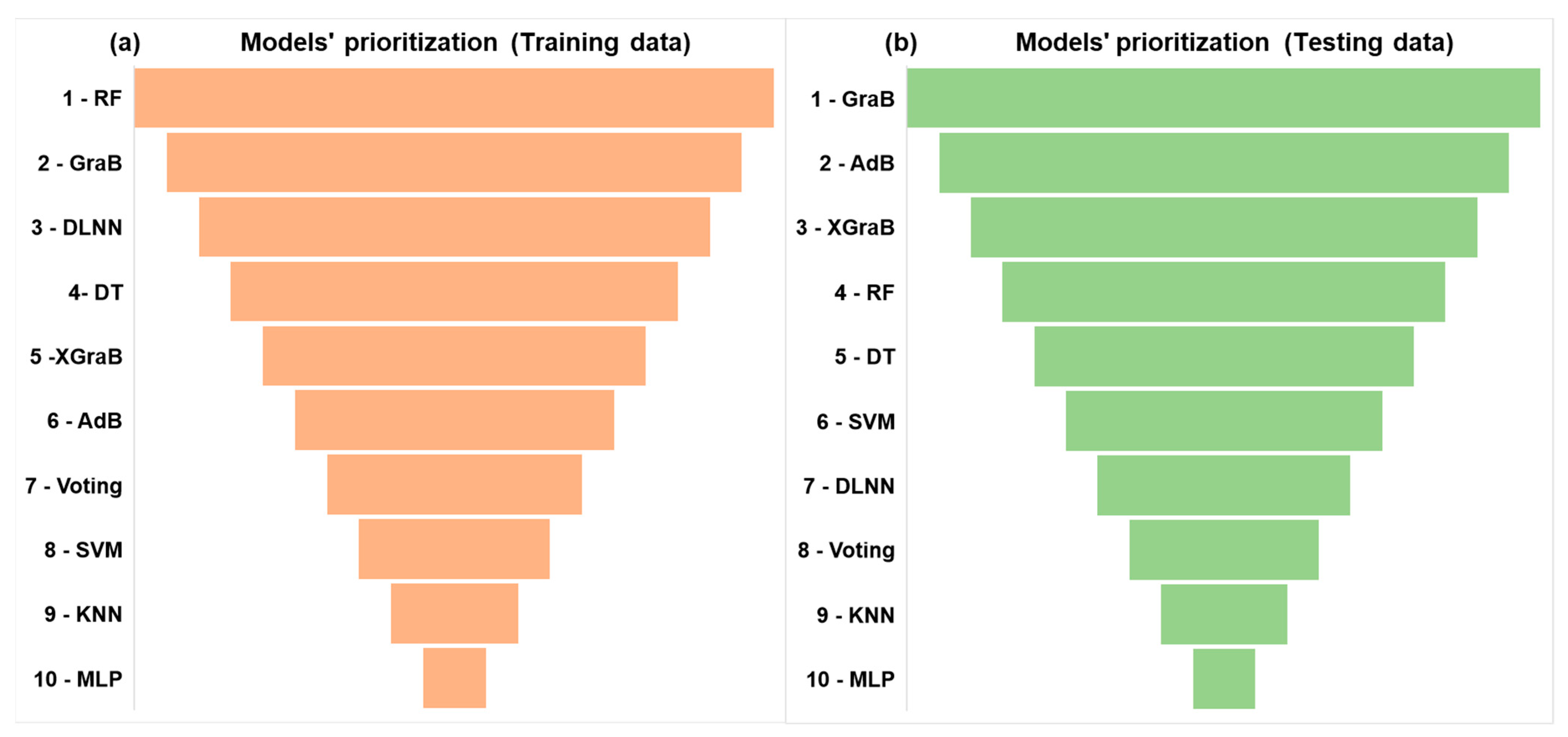
| Data | Source | |
|---|---|---|
| Water withdrawal points inventory | Field investigation Data collection from: the Hydraulic Agency of Guir, Ziz, Rheris Basin (ABHGZR) the Regional Office of Agricultural Development (ORMVAO) the National Office of Electricity and Drinking Water (ONEE) | |
| GPM_3IMERGM v06 produced by the Global Precipitation Measurement (GPM) mission [43]. Pixel size: 10 km × 10 km | https://giovanni.gsfc.nasa.gov/giovanni/ (Accessed on 1 July 2022) | |
| Digital Elevation Model (DEM) Produced by ALOS PALSAR. Pixel size: 12.5 m × 12.5 m | https://vertex.daac.asf.alaska.edu/ (Accessed on 1 July 2022) | |
| Landsat Oli-8 images. Pixel size: 30 m × 30 m | https://earthexplorer.usgs.gov/ (Accessed on 1 July 2022) | |
| Geological Maps. Scale: 1/200,000 | Jbel Saghro-Dades | Geological service of Morocco |
| Toudgha Maider | ||
| Ouaouizaght Dades | ||
| Haut Atlas of Midelt | ||
| Model | Developed by | Description | Applied by |
|---|---|---|---|
| MLP | Rosenblatt [54] and Rumelhart et al. [55] | Multilayer perceptron is a fully connected, feedforward artificial neural network (ANN) comprising several nodes, including three layers, as the input layer (i.e., GWP-influencing factor), a hidden layer (i.e., weights application), and an output layer (i.e., GWP). | Farooq et al. [56] and Kanj et al. [57] |
| KNN | Fix and Hodges [58] and Cover and Hart [59] | K-nearest neighbor is founded on the collector theory. The prediction of a new data point (i.e., GWP) is based on the simple majority vote of its nearest real data points (i.e., water withdrawal points and non- water withdrawal points). | Kombo et al. [60] and Aburub et al. [61] |
| DT (CART) | Breiman et al. [62] | Decision tree is structured like a tree, where the algorithm selects the most suitable features (i.e., GWP-influencing factor) as a root and generates the child nodes. The prediction is based on top-down observations and processing results at each level, from the rote to the child nodes corresponding to the new data (i.e., GWP). | Zhao et al. [63] and Choubin et al. [64] |
| SVM | Vapnik [65,66] | Support vector machine is a non-parametric kernel-based model aimed at locating a maximum margin separation hyperplane in the n-dimensional feature space. The radial basis function was used to predict the GWP. | Liu et al. [67] and Ijlil et al. [68] |
| Voting | Littlestone and Warmuth [69] | Defined as a hybrid model, it is based on an aggregation approach that combines the results of several algorithms. In this study, it was used for the shallow (i.e., DT, SVM, MLP, and KNN) models to balance out their individual weaknesses. | Saqlain et al. [70] and Gandhi and Pandey [16] |
| RF | Breiman et al. [71] | Random forest is a meta-estimator that adjusts a given number of DT classifiers on various subsets of the GWP-influencing factors obtained by the bootstrap aggregation (i.e., bagging) and random feature selection methods. It serves to optimize the predictive efficiency of the model. | Das and Saha [23], Liu et al. [14] |
| AdB | Freund and Schapire [72] | Adaptive boosting is an ensemble learning algorithm; it is founded on combining several basic and weak predictors to produce more effective trees. It tweaks the instance weights at every interaction. | Mosavi et al. [26] |
| GraB | Ridgeway [73] | Gradient Boosting is also known as gradient tree boosting, and its approach is like the AdB algorithm. It serves to minimizes the overall prediction error (i.e., the loss function). | Park and Kim [13] |
| XGraB | Chen and Guestrin [74] | eXtreme Gradient Boosting is an improved GraB algorithm with a structure offering parallel tree boosting. It employs second-order derivatives that reduce the loss function and provide more accurate trees. | Naghibi et al. [21], Park and Kim [13] |
| DLNN | Kingma and Ba [75] | Deep learning neural network is an advanced ANN that consists of several layers: the input layer, several hidden layers, and the output layer. | Pradhan et al. [76] |
| Model | Performance Indicators | ||||||||
|---|---|---|---|---|---|---|---|---|---|
| Se | Sp | Pr | FPR | Ac | F1-Score | MAE | RMSE | AUC | |
| Training Data | |||||||||
| RF | 1.00 | 1.00 | 1.00 | 0.00 | 1.00 | 1.00 | 0.00 | 0.00 | 1.00 |
| MLP | 0.83 | 0.70 | 0.70 | 0.30 | 0.76 | 0.76 | 0.24 | 0.24 | 0.85 |
| GraB | 0.91 | 0.87 | 0.86 | 0.13 | 0.89 | 0.88 | 0.11 | 0.33 | 0.96 |
| AdB | 0.84 | 0.83 | 0.80 | 0.17 | 0.83 | 0.82 | 0.17 | 0.41 | 0.91 |
| DT | 0.89 | 0.85 | 0.83 | 0.15 | 0.87 | 0.86 | 0.13 | 0.36 | 0.92 |
| SVM | 0.81 | 0.82 | 0.79 | 0.18 | 0.82 | 0.80 | 0.18 | 0.43 | 0.88 |
| KNN | 0.76 | 0.84 | 0.80 | 0.16 | 0.81 | 0.78 | 0.19 | 0.44 | 0.88 |
| XGraB | 0.86 | 0.84 | 0.82 | 0.16 | 0.85 | 0.84 | 0.15 | 0.38 | 0.91 |
| Voting | 0.84 | 0.82 | 0.79 | 0.18 | 0.83 | 0.81 | 0.17 | 0.42 | 0.95 |
| DLNN | 0.88 | 0.88 | 0.86 | 0.12 | 0.88 | 0.87 | 0.12 | 0.35 | 0.89 |
| Testing Data | |||||||||
| RF | 0.83 | 0.79 | 0.78 | 0.21 | 0.80 | 0.80 | 0.20 | 0.44 | 0.89 |
| MLP | 0.81 | 0.64 | 0.67 | 0.36 | 0.72 | 0.73 | 0.28 | 0.53 | 0.85 |
| GraB | 0.87 | 0.80 | 0.80 | 0.20 | 0.83 | 0.83 | 0.17 | 0.41 | 0.91 |
| AdB | 0.87 | 0.78 | 0.78 | 0.22 | 0.82 | 0.82 | 0.18 | 0.42 | 0.89 |
| DT | 0.83 | 0.78 | 0.77 | 0.22 | 0.80 | 0.80 | 0.20 | 0.44 | 0.81 |
| SVM | 0.80 | 0.77 | 0.76 | 0.23 | 0.79 | 0.78 | 0.21 | 0.46 | 0.88 |
| KNN | 0.77 | 0.78 | 0.76 | 0.22 | 0.77 | 0.76 | 0.23 | 0.47 | 0.87 |
| XGraB | 0.86 | 0.78 | 0.78 | 0.22 | 0.82 | 0.82 | 0.18 | 0.43 | 0.94 |
| Voting | 0.80 | 0.76 | 0.75 | 0.24 | 0.78 | 0.77 | 0.22 | 0.47 | 0.88 |
| DLNN | 0.81 | 0.76 | 0.76 | 0.24 | 0.79 | 0.78 | 0.21 | 0.46 | 0.88 |
Disclaimer/Publisher’s Note: The statements, opinions and data contained in all publications are solely those of the individual author(s) and contributor(s) and not of MDPI and/or the editor(s). MDPI and/or the editor(s) disclaim responsibility for any injury to people or property resulting from any ideas, methods, instructions or products referred to in the content. |
© 2023 by the authors. Licensee MDPI, Basel, Switzerland. This article is an open access article distributed under the terms and conditions of the Creative Commons Attribution (CC BY) license (https://creativecommons.org/licenses/by/4.0/).
Share and Cite
Ouali, L.; Kabiri, L.; Namous, M.; Hssaisoune, M.; Abdelrahman, K.; Fnais, M.S.; Kabiri, H.; El Hafyani, M.; Oubaassine, H.; Arioua, A.; et al. Spatial Prediction of Groundwater Withdrawal Potential Using Shallow, Hybrid, and Deep Learning Algorithms in the Toudgha Oasis, Southeast Morocco. Sustainability 2023, 15, 3874. https://doi.org/10.3390/su15053874
Ouali L, Kabiri L, Namous M, Hssaisoune M, Abdelrahman K, Fnais MS, Kabiri H, El Hafyani M, Oubaassine H, Arioua A, et al. Spatial Prediction of Groundwater Withdrawal Potential Using Shallow, Hybrid, and Deep Learning Algorithms in the Toudgha Oasis, Southeast Morocco. Sustainability. 2023; 15(5):3874. https://doi.org/10.3390/su15053874
Chicago/Turabian StyleOuali, Lamya, Lahcen Kabiri, Mustapha Namous, Mohammed Hssaisoune, Kamal Abdelrahman, Mohammed S. Fnais, Hichame Kabiri, Mohammed El Hafyani, Hassane Oubaassine, Abdelkrim Arioua, and et al. 2023. "Spatial Prediction of Groundwater Withdrawal Potential Using Shallow, Hybrid, and Deep Learning Algorithms in the Toudgha Oasis, Southeast Morocco" Sustainability 15, no. 5: 3874. https://doi.org/10.3390/su15053874
APA StyleOuali, L., Kabiri, L., Namous, M., Hssaisoune, M., Abdelrahman, K., Fnais, M. S., Kabiri, H., El Hafyani, M., Oubaassine, H., Arioua, A., & Bouchaou, L. (2023). Spatial Prediction of Groundwater Withdrawal Potential Using Shallow, Hybrid, and Deep Learning Algorithms in the Toudgha Oasis, Southeast Morocco. Sustainability, 15(5), 3874. https://doi.org/10.3390/su15053874












